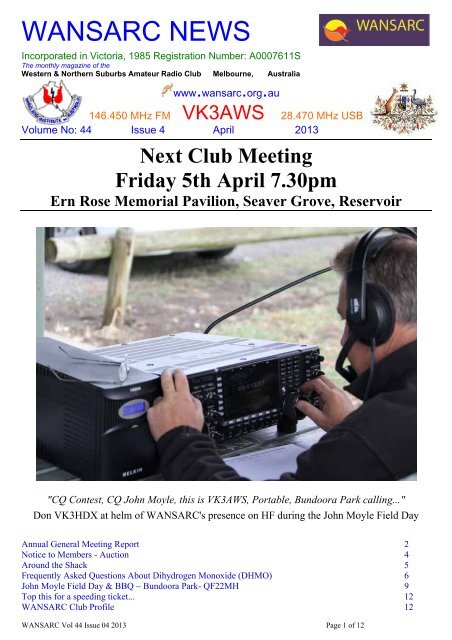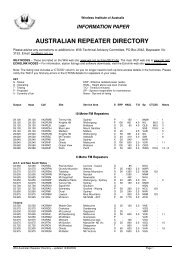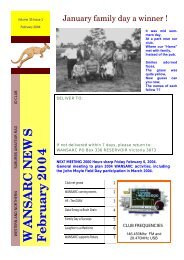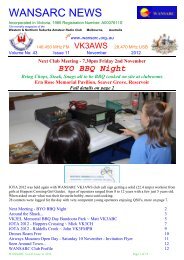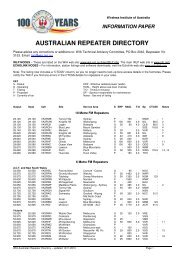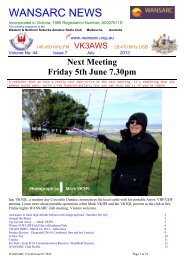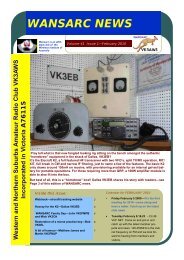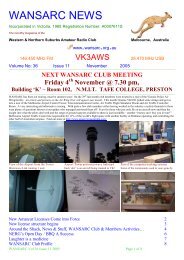April - Western & Northern Suburbs Amateur Radio Club
April - Western & Northern Suburbs Amateur Radio Club
April - Western & Northern Suburbs Amateur Radio Club
You also want an ePaper? Increase the reach of your titles
YUMPU automatically turns print PDFs into web optimized ePapers that Google loves.
WANSARC NEWS<br />
Incorporated in Victoria, 1985 Registration Number: A0007611S<br />
The monthly magazine of the<br />
<strong>Western</strong> & <strong>Northern</strong> <strong>Suburbs</strong> <strong>Amateur</strong> <strong>Radio</strong> <strong>Club</strong> Melbourne, Australia<br />
www.wansarc.org.au<br />
146.450 MHz FM VK3AWS 28.470 MHz USB<br />
Volume No: 44 Issue 4 <strong>April</strong> 2013<br />
Next <strong>Club</strong> Meeting<br />
Friday 5th <strong>April</strong> 7.30pm<br />
Ern Rose Memorial Pavilion, Seaver Grove, Reservoir<br />
"CQ Contest, CQ John Moyle, this is VK3AWS, Portable, Bundoora Park calling..."<br />
Don VK3HDX at helm of WANSARC's presence on HF during the John Moyle Field Day<br />
Annual General Meeting Report 2<br />
Notice to Members - Auction 4<br />
Around the Shack 5<br />
Frequently Asked Questions About Dihydrogen Monoxide (DHMO) 6<br />
John Moyle Field Day & BBQ ~ Bundoora Park- QF22MH 9<br />
Top this for a speeding ticket... 12<br />
WANSARC <strong>Club</strong> Profile 12<br />
WANSARC Vol 44 Issue 04 2013 Page 1 of 12
Annual General Meeting Report<br />
LAST MONTHS MEETING<br />
Last meeting was the Annual General Meeting, which was held in interesting artistic surrounds, at the Ern Rose clubrooms.<br />
The AGM election results from offers made and acceptance by those present was as listed.<br />
Position<br />
President<br />
Vice President<br />
Secretary / Public Officer / QSL Manager<br />
Treasurer<br />
<strong>Radio</strong> Officer<br />
Webmaster<br />
Magazine Editor<br />
Committee #1<br />
Committee #2<br />
Committee #3<br />
Committee #4<br />
Committee #5<br />
WIA Assessor<br />
Person<br />
Frank VK3OP<br />
John VK3FEZZ<br />
Mark VK3PI<br />
Rod VK3FAB<br />
Vacant, candidate sought at the <strong>April</strong> meeting<br />
Rod VK3FAB<br />
Mick VK3CH<br />
Gordon VK3YOD<br />
Don VK3HDX<br />
John VK3FMPB<br />
Graeme VK3NE<br />
Frank VK3ZO<br />
Mick VK3CH<br />
NEW MEMBERSHIP FEES<br />
For the first time, not since since the late 1980's, club membership fees were increased and this was approved at the AGM.<br />
Previous yearly fees were Retired / Student $10 Employed $20<br />
New yearly fees are now Retired / Student $15 Employed $25<br />
A new fee category of "Family Membership" was introduced at $40<br />
Fees have increased as costs have risen over time and other factors such as no generous donations to the club this year, no Rotary<br />
Raffle any more as they have disbanded and the requirement to pay back adjusted rental on Ern Rose club room hire to the council.<br />
RADIO OFFICER VACANCY<br />
<strong>Radio</strong> Officer position is currently vacant. The position governs the use of VK3AWS callsign and the coordination of the weekly<br />
club Net operators and log keeping (if not undertaken by candidate)<br />
Position is to be offered at next general meeting. So if your interested please put your name forward at the <strong>April</strong> meeting.<br />
WANSARC Vol 44 Issue 04 2013 Page 2 of 12
EQUIPMENT DONATION AUCTION<br />
<strong>April</strong> meeting will have an auction of the equipment donation to WANSARC from Eric. All sale proceeds go to the club.<br />
The equipment was brought for viewing at the last meeting.<br />
A complete list will be sent out to all members, so remember to bring your cash along to the <strong>April</strong> meeting.<br />
The list of items up for auction will be emailed with a rough valuation where it is able to be evaluated.<br />
In any case the prices will be typical WANSARC value for money, as anyone that has seen a WANSARC auction would know!<br />
Some of the gear to auctioned next meeting ↓<br />
Coffee break time... except for Treasurer Rod, who didn't leave his post all night, writing furiously away collecting membership dues.<br />
Remember membership forms and payment need to be<br />
submitted by next meeting in <strong>April</strong>.<br />
Don't for forget you can pay online now.<br />
Members have the option to pay their membership fees<br />
via internet banking and direct deposit, details:<br />
Bank Name:<br />
Bendigo Bank<br />
BSB Number: 633-000<br />
Account Number: 139996052<br />
Account Name:<br />
<strong>Western</strong> and <strong>Northern</strong> <strong>Suburbs</strong> <strong>Amateur</strong> <strong>Radio</strong> <strong>Club</strong><br />
Please quote your callsign and “renewal” as the<br />
reference.<br />
Rod collecting the cash →<br />
If paying by internet banking or direct deposit, please<br />
send Rod an email rod.tacey@gmail.com and Rod will<br />
confirm receipt.<br />
Alternatively, you can send us a money order or cheque<br />
made out to<br />
"<strong>Western</strong> and <strong>Northern</strong> <strong>Suburbs</strong> <strong>Amateur</strong> <strong>Radio</strong> <strong>Club</strong>" Posted to WANSARC, PO Box 336, Reservoir VIC 3073.<br />
WANSARC Vol 44 Issue 04 2013 Page 3 of 12
NOTICE TO MEMBERS<br />
HAVE YOU RENEWED YOUR MEMBERSHIP<br />
ARE YOU A FINANCIAL MEMBER OF WANSARC<br />
Well make sure you are by Friday <strong>April</strong> 5, 2013.<br />
WHY, I hear you ask<br />
Because that is when the first auction night for the year occurs and only FINANCIAL members of<br />
WANSARC will have the opportunity to bid for equipment.<br />
On offer are an assortment of pre-loved goodies including the following:<br />
IC3200A<br />
IC900A<br />
IC720A<br />
IC738<br />
FT480R<br />
FT730R<br />
Mirage B108 RF Power Amplifier AND<br />
MUCH MUCH MORE!!!<br />
So get cracking, membership is only $25 for working types and $15 for those that are not working,<br />
retired or students. A bargain price at any rate!<br />
No warranty, no guarantee’s, what you see is what you get.<br />
But hey, that is all part of the fun!<br />
SEE YOU ON<br />
FRIDAY, APRIL 5, 2013 AT THE CLUBROOMS<br />
GEAR ABLE TO BE VIEWED FROM 7.10pm<br />
Auction commences 8.00PM SHARP!!<br />
Best wishes<br />
`tÜ~ ] fàxÑ{xÇáÉÇ<br />
Mark VK3PI<br />
Secretary<br />
WANSARC Vol 44 Issue 04 2013 Page 4 of 12
Around the Shack<br />
FOUNDATION LICENCE 2013 WEEKEND COURSES<br />
<strong>April</strong> 20-21, June 22-23, August 24-25, November 16-17.<br />
Courses are held at the <strong>Amateur</strong> <strong>Radio</strong> Victoria office 40G<br />
Victory Blvd, Ashburton.<br />
The study and operational practice guide book for the Foundation<br />
Licence. Mail orders $26.00 - delivery Australia wide.<br />
To enrol or obtain the Foundation licence manual contact<br />
- Barry Robinson VK3PV 0428 516 001<br />
PA EQUIPMENT THREATENED BY BROADBAND SALE<br />
GYM instructors and clerics could struggle to get their message<br />
across when the federal government sells the rights to broadcast<br />
frequencies used by analogue television, and wireless<br />
microphones. In <strong>April</strong> the government will auction a spectrum in<br />
the 700 megahertz bandwidth freed by the switch to digital<br />
television. Telecommunications companies Optus, Telstra and<br />
Vodafone have registered their interest in bidding for frequencies<br />
which will allow them to expand their wireless broadband<br />
services for fourth-generation mobile phones.<br />
But shadow communications minister Malcolm Turnbull says the<br />
Broadcasting Legislation Amendment (Digital Dividend) Bill<br />
needs to be amended so popular wireless microphone technology<br />
does not become obsolete.<br />
He says there are 120,000 to 150,000 wireless microphone units<br />
in Australia that could be affected. The takeover of the<br />
bandwidth is not scheduled until 2015, but there have been calls<br />
for buyers to be able to use it beforehand. "You can imagine the<br />
consequences are going to be shocking. This has the potential of<br />
interfering with tens of thousands of businesses."<br />
He called on the government to introduce an education campaign<br />
for users and sellers of the technology so they could plan for<br />
2015. The Australian Communications and Media Authority<br />
website says planning is at an early stage and updates will be<br />
provided as they become available.<br />
Speaking on the bill in parliament, Mr Turnbull was also critical<br />
of the government's auction reserve price of $1.36 per megahertz<br />
per head of the population, double what was achieved in a recent<br />
similar sale in the United Kingdom.<br />
Mr Turnbull said the government should lower the reserve and<br />
stop subsidising the NBN.<br />
"They are subsidising the form of broadband that has the smaller<br />
contribution to productivity and gouging the medium of<br />
broadband that has the maximum benefit," he said. ~Internet<br />
Beer Traditions ‐ The Honeymoon<br />
4,000 years ago in Babylon, it was an accepted practice that for a month after the<br />
wedding, the bride's father would supply his son-in-law with all the mead or beer<br />
he could drink. In ancient Babylon, the calendar was lunar-based - based on the<br />
cycle of the moon. The month following any wedding was called the "honey<br />
month" which evolved into "honeymoon". Mead is a honey beer and what better<br />
way to celebrate a honeymoon. ~Internet<br />
THE POWER OF GROG<br />
Beer built the Great Pyramid of Gaza<br />
Experts of ancient history will tell you that beer was an incredibly<br />
valuable commodity in Ancient Egypt. It is believed that beer<br />
predates bread by as much as 3000 years and that it was the desire<br />
to harvest barley for beer-making that compelled our ancestors to<br />
cultivate crops and settle in one place.<br />
In humankind's efforts to produce beer we discovered the plough,<br />
irrigation, the wheel, pottery and bread making. By the time that<br />
the Egyptians started constructing pyramids, beer was used as a<br />
currency to pay, feed and placate the workforce. In this time beer<br />
was very thick and nutritious, and much safer to drink than the<br />
contaminated water of the Nile. Many wonders of the ancient<br />
world would never have been constructed without beer as a<br />
means to sustain the workforce.<br />
Alcohol gave birth to modern medicine<br />
Whilst alcohol is used in antiseptic wipes and hand sanitisers in<br />
medical practice today (pure ethanol is very effective at killing<br />
bacteria, viruses and fungi) papyri from Ancient Egypt dating to<br />
2200 BC include recipes for medicine based on wine.<br />
This oldest documented man-made medicine set a precedent for<br />
the use of alcohol in medicine for the next 4000 years, to this day.<br />
Hippocrates, the father of medicine and from where we get the<br />
Hippocratic Oath, included wine in every one of his recorded<br />
remedies.<br />
The Schola Medica Salernitana, founded in the 9th century in the<br />
southern Italian town of Salerno, used the new-fangled technique<br />
of distillation to concentrate wine into a spirit which was used for<br />
creating infusions of herbs and spices believed to have healthgiving<br />
properties. These types of medicines would eventually be<br />
used to combat (unsuccessfully) the bubonic plague that<br />
decimated Europe's population.<br />
The classic G&T also started its life as a medicine. Troops of the<br />
British East India Company were plagued by malaria but by<br />
taking a good dose of quinine dissolved in water they could be<br />
cured. For many of the troops, however, the bitter-tasting cure<br />
seemed worse than the disease. It wasn't until the quinine tonic<br />
water was mixed with a little sugar and a good slug of gin that the<br />
cure really caught on.<br />
Before proper anaesthesia, a stiff drink was the best you could<br />
expect to be offered before surgery. These days alcohol has been<br />
largely relegated to cold sore and toothache gels and cough<br />
syrups.<br />
Alcohol helped us discover the New World<br />
Long sea voyages pose the problems of stagnant drinking water<br />
and boredom. These were two problems that alcohol was<br />
immediately employed to solve. Stores of sherry and wine helped<br />
Christopher Columbus make it to the Bahamas.<br />
In 1519, as Magellan prepared to circumnavigate the globe, he<br />
spent more on sherry than he did on weapons. Later seafarers<br />
favoured brandy, rum and gin as it took up less space on-board<br />
than beer or wine.<br />
With the sugar plantations of the Caribbean selling cheap<br />
molasses to the colonies in New England, rum very quickly<br />
became an important part of the economy. As Britain saw that<br />
they might profit from the tax on rum, and that they might use the<br />
American colonies as a solution to their growing convict issues,<br />
they consequently ignited the independence movement and the<br />
Revolutionary War.<br />
With the uppity Americans not wanting convicts as neighbours,<br />
Australia was next on the cards. The First Fleet consisting of 11<br />
vessels was not only laden with troops, convicts and the tools for<br />
starting a new colony, but also five puncheons of rum (1600<br />
litres) and 300 gallons of brandy (1350 litres).<br />
After crossing the Atlantic the fleet also stopped to top up on<br />
provisions at Rio De Janeiro where they would have taken on the<br />
local sugarcane spirit cachaça. It's likely that the fleet's arrival in<br />
Botany Bay would have been toasted not with English gin,<br />
brandy or sherry, but with Brazilian spirit. ~Internet<br />
RAOTC LUNCHEON 2013<br />
Mick VK3CH, Mark VK3PI, Ian VK3QL and John VK3ACA<br />
attended, most of NERG 'gainfully unemployed' were in<br />
attendance as well. An interesting talk on clandestine radio and<br />
other subjects was given which only finished at 3pm. Ten full<br />
tables in the larger upstairs room had many in conversation<br />
enjoying the meal and general table rag chewing.<br />
EMDRC HAMFEST 2013<br />
About a dozen WANSARC members were seen wandering<br />
around the Hamfest, that had good weather. Crowd numbers<br />
seemed down, normally you cop an elbow in the ribs as you walk<br />
around but not this time. Mick was the only one from<br />
WANSARC selling, making $125 for the day, enough to fill the<br />
tank and enjoy a few good meals.<br />
WANSARC Vol 44 Issue 04 2013 Page 5 of 12
Frequently Asked Questions About<br />
Dihydrogen Monoxide (DHMO)<br />
Why haven't I heard about Dihydrogen Monoxide before<br />
Good question. Historically, the dangers of DHMO, for the most<br />
part, have been considered minor and manageable. While the<br />
more significant dangers of Dihydrogen Monoxide are currently<br />
addressed by a number of agencies including FDA, FEMA and<br />
CDC, public awareness of the real and daily dangers of<br />
Dihydrogen Monoxide is lower than some think it should be.<br />
Critics of government often cite the fact that many politicians and<br />
others in public office do not consider Dihydrogen Monoxide to<br />
be a "politically beneficial" cause to get behind, and so the public<br />
suffers from a lack of reliable information on just what DHMO is<br />
and why they should be concerned. Part of the blame<br />
lies with the public and society at large. Many do not take the<br />
time to understand Dihydrogen Monoxide, and what it means to<br />
their lives and the lives of their families.<br />
Unfortunately, the dangers of DHMO have increased as world<br />
population has increased, a fact that the raw numbers and careful<br />
research both bear out. Now more than ever, it is important to be<br />
aware of just what the dangers of Dihydrogen Monoxide are and<br />
how we can all reduce the risks faced by ourselves and our<br />
families.<br />
What is Dihydrogen Monoxide<br />
Dihydrogen Monoxide (DHMO) is a colourless and odourless<br />
chemical compound, also referred to by some as Dihydrogen<br />
Oxide, Hydrogen Hydroxide, Hydronium Hydroxide, or simply<br />
Hydric acid. Its basis is the highly reactive hydroxyl radical, a<br />
species shown to mutate DNA, denature proteins, disrupt cell<br />
membranes, and chemically alter critical neurotransmitters. The<br />
atomic components of DHMO are found in a number of caustic,<br />
explosive and poisonous compounds such as Sulphuric Acid,<br />
Nitro-glycerine and Ethyl Alcohol.<br />
For more detailed information, including precautions, disposal<br />
procedures and storage requirements, refer to one of the Material<br />
Safety Data Sheets (MSDS) available for DHMO:<br />
Kemp Compliance & Safety MSDS for DHMO<br />
Chem-Safe, Inc. MSDS for Dihydrogen Monoxide<br />
Applied Petrochemical Research MSDS for Hydric Acid<br />
Original DHMO.org Material Safety Data Sheet (MSDS) for<br />
Dihydrogen Monoxide (html)<br />
Should I be concerned about Dihydrogen Monoxide<br />
Yes, you should be concerned about DHMO! Although the U.S.<br />
Government and the Centres for Disease Control (CDC) do not<br />
classify Dihydrogen Monoxide as a toxic or carcinogenic<br />
substance (as it does with better known chemicals such as<br />
hydrochloric acid and benzene), DHMO is a constituent of many<br />
known toxic substances, diseases and disease-causing agents,<br />
environmental hazards and can even be lethal to humans in<br />
quantities as small as a thimbleful.<br />
Research conducted by award-winning U.S. scientist Nathan<br />
Zohner concluded that roughly 86 percent of the population<br />
supports a ban on dihydrogen monoxide. Although his results are<br />
preliminary, Zohner believes people need to pay closer attention<br />
to the information presented to them regarding Dihydrogen<br />
Monoxide. He adds that if more people knew the truth about<br />
DHMO then studies like the one he conducted would not be<br />
necessary.<br />
A similar study conducted by U.S. researchers Patrick K.<br />
McCluskey and Matthew Kulick also found that nearly 90 percent<br />
of the citizens participating in their study were willing to sign a<br />
petition to support an outright ban on the use of Dihydrogen<br />
Monoxide in the United States.<br />
What are some of the dangers associated with DHMO<br />
Each year, Dihydrogen Monoxide is a known causative<br />
component in many thousands of deaths and is a major<br />
contributor to millions upon millions of dollars in damage to<br />
property and the environment. Some of the known perils of<br />
Dihydrogen Monoxide are:<br />
Death due to accidental inhalation of DHMO, even in small<br />
quantities.<br />
Prolonged exposure to solid DHMO causes severe tissue damage.<br />
Excessive ingestion produces a number of unpleasant though not<br />
typically life-threatening side-effects.<br />
DHMO is a major component of acid rain.<br />
Gaseous DHMO can cause severe burns.<br />
Contributes to soil erosion.<br />
Leads to corrosion and oxidation of many metals.<br />
Contamination of electrical systems often causes short-circuits.<br />
Exposure decreases effectiveness of automobile brakes.<br />
Found in biopsies of pre-cancerous tumours and lesions.<br />
Given to vicious dogs involved in recent deadly attacks.<br />
Often associated with killer cyclones in the U.S. Midwest and<br />
elsewhere, and in hurricanes including deadly storms in Florida,<br />
New Orleans and other areas of the south-eastern U.S.<br />
Thermal variations in DHMO are a suspected contributor to the<br />
El Nino weather effect.<br />
What are some uses of Dihydrogen Monoxide<br />
Despite the known dangers of DHMO, it continues to be used<br />
daily by industry, government, and even in private homes across<br />
the U.S. and worldwide. Some of the well-known uses of<br />
Dihydrogen Monoxide are:<br />
as an industrial solvent and coolant,<br />
in nuclear power plants,<br />
by the U.S. Navy in the propulsion systems of some older vessels,<br />
by elite athletes to improve performance,<br />
in the production of Styrofoam,<br />
in biological and chemical weapons manufacture,<br />
in the development of genetically engineering crops and animals,<br />
as a spray-on fire suppressant and retardant,<br />
in so-called "family planning" or "reproductive health" clinics,<br />
as a major ingredient in many home-brewed bombs,<br />
as a by-product of hydrocarbon combustion in furnaces and air<br />
conditioning compressor operation,<br />
WANSARC Vol 44 Issue 04 2013 Page 6 of 12
in cult rituals,<br />
by the Church of Scientology on their members and their<br />
members' families (although surprisingly, many members<br />
recently have contacted DHMO.org to vehemently deny such<br />
use),<br />
by both the KKK and the NAACP during rallies and marches,<br />
by members of Congress who are under investigation for<br />
financial corruption and inappropriate IM behaviour,<br />
by the clientele at a number of bath houses in New York City and<br />
San Francisco,<br />
historically, in Hitler's death camps in Nazi Germany, and in<br />
prisons in Turkey, Serbia, Croatia, Libya, Iraq and Iran,<br />
in World War II prison camps in Japan, and in prisons in China,<br />
for various forms of torture,<br />
during many recent religious and ethnic wars in the Middle East,<br />
by many terrorist organizations including al Qaeda,<br />
in community swimming pools to maintain chemical balance,<br />
in day care centres, purportedly for sanitary purposes,<br />
by software engineers, including those producing DICOM<br />
software and other DICOM software tools,<br />
by popular computer science professors,<br />
by the semi-divine King Bhumibol of Thailand and his many<br />
devoted young working girls in Bangkok,<br />
by the British Chiropractic Association and the purveyors of the<br />
bogus treatments that the BCA promotes,<br />
by commodities giant Trafigura in their well-publicized and<br />
widely-known toxic-waste dumping activities in Ivory Coast,<br />
in animal research laboratories, and<br />
in pesticide production and distribution.<br />
What you may find surprising are some of the products and<br />
places where DHMO is used, but which for one reason or<br />
another, are not normally made part of public presentations on the<br />
dangers to the lives of our family members and friends.<br />
Among these startling uses are:<br />
as an additive to food products, including jarred baby food and<br />
baby formula, and even in many soups, carbonated beverages and<br />
supposedly "all-natural" fruit juices<br />
in cough medicines and other liquid pharmaceuticals,<br />
in spray-on oven cleaners,<br />
in shampoos, shaving creams, deodorants and numerous other<br />
bathroom products,<br />
in bathtub bubble products marketed to children,<br />
as a preservative in grocery store fresh produce sections,<br />
in the production of beer by all the major beer distributors,<br />
in the coffee available at major coffee houses in the US and<br />
abroad,<br />
in Formula One race cars, although its use is regulated by the<br />
Formula One Racing Commission, and<br />
as a target of ongoing NASA planetary and stellar research.<br />
One of the most surprising facts recently revealed about<br />
Dihydrogen Monoxide contamination is in its use as a food and<br />
produce "decontaminant." Studies have shown that even after<br />
careful washing, food and produce that has been contaminated by<br />
DHMO remains tainted by DHMO.<br />
What is the link between Dihydrogen Monoxide and school<br />
violence<br />
A recent stunning revelation is that in every single instance of<br />
violence in our country's schools, including infamous shootings in<br />
high schools in Denver and Arkansas, Dihydrogen Monoxide was<br />
involved. In fact, DHMO is often very available to students of all<br />
ages within the assumed safe confines of school buildings. None<br />
of the school administrators with which we spoke could say for<br />
certain how much of the substance is in use within their very<br />
hallways.<br />
How does Dihydrogen Monoxide toxicity affect kidney<br />
dialysis patients<br />
Unfortunately, DHMO overdose is not unheard of in patients<br />
undergoing dialysis treatments for kidney failure. Dihydrogen<br />
Monoxide overdose in these patients can result in congestive<br />
heart failure, pulmonary edema and hypertension. In spite of the<br />
danger of accidental overdose and the inherent toxicity of DHMO<br />
in large quantities for this group, there is a portion of the dialysis<br />
treated population that continues to use DHMO on a regular<br />
basis.<br />
Are there groups that oppose a ban on Dihydrogen<br />
Monoxide<br />
In spite of overwhelming evidence, there is one group in<br />
California that opposes a ban on Dihydrogen Monoxide. The<br />
Friends of Hydrogen Hydroxide is a group that believes that the<br />
dangers of DHMO have been exaggerated. Members claim that<br />
Dihydrogen Monoxide, or the less emotionally charged and more<br />
chemically accurate term they advocate for it, "Hydrogen<br />
Hydroxide," is beneficial, environmentally safe, benign and<br />
naturally occurring. They argue that efforts to ban DHMO are<br />
misguided.<br />
Friends of Hydrogen Hydroxide is supported by the Scorched<br />
Earth Party, a radical and loosely-organized California-based<br />
group. Sources close to the Scorched Earth Party deny any<br />
outside funding from government, industry or pro-industry PACs.<br />
Is it true that using DHMO improves athletic performance<br />
Absolutely!<br />
With the numerous allegations of amateur and professional<br />
athletes using anabolic steroids and/or blood doping to enhance<br />
performance, virtually no attention has been paid to the<br />
performance enhancing properties of Dihydrogen Monoxide. It is<br />
perhaps the sporting world's dirtiest of dirty little secrets that<br />
athletes regularly ingest large quantities of DHMO in an effort to<br />
gain a competitive edge over an opponent.<br />
One technique commonly used by endurance athletes in sports<br />
such as distance running and cycling is to take a large amount of<br />
DHMO immediately prior to a race. This is known within racing<br />
circles to dramatically improve performance.<br />
Sports-medicine physicians warn that ingesting too much<br />
Dihydrogen Monoxide can lead to complications and unwanted<br />
side-effects, but do acknowledge the link to improved<br />
performance. DHMO is not currently considered a banned<br />
substance, so post-race urine tests do not detect elevated or<br />
abnormal levels of DHMO.<br />
What are the symptoms of accidental Dihydrogen Monoxide<br />
overdose<br />
You may not always recognize that you have been a victim of<br />
accidental DHMO overdose, so here are some signs and<br />
symptoms to look for.<br />
If you suspect Dihydrogen Monoxide overdose, or if you exhibit<br />
any of these symptoms, you should consult with your physician<br />
or medical practitioner.<br />
The data presented here is provided for informational purposes<br />
only, and should in no way be construed as medical advice of any<br />
sort.<br />
WANSARC Vol 44 Issue 04 2013 Page 7 of 12
Watch for these symptoms:<br />
Excessive sweating<br />
Excessive urination<br />
Bloated feeling<br />
Nausea<br />
Vomiting<br />
Electrolyte imbalance<br />
Hyponatremia (serum hypotonicity)<br />
Dangerously imbalanced levels of ECF and ICF in the blood<br />
Degeneration of sodium homeostasis<br />
A recently noted medical phenomenon involves small amounts of<br />
DHMO leaking or oozing from the corners of the eyes as a direct<br />
result of causes such as foreign particulate irritation, allergic<br />
reactions including anaphylactic shock, and sometimes severe<br />
chemical depression.<br />
What is a chemical analysis of Dihydrogen Monoxide<br />
Recently, German analytical chemist Christoph von<br />
Bueltzingsloewen at the Universitaet Regensburg identified what<br />
may be key reasons why the dangers of DHMO are ever present.<br />
According to von Bueltzingsloewen, the chemical separation of<br />
dihydrogenoxide from the hazardous oxygendihydride is<br />
extremely difficult. The two similar compounds curiously occur<br />
in nearly equi molar distribution wherever they are found. It is not<br />
clear how the two contribute directly to the dangers inherent in<br />
Dihydrogen Monoxide, although von Bueltzingsloewen believes<br />
that a synergetic mechanism, catalysed by traces of hydrogen<br />
hydroxide, plays a major role.<br />
What can I do to minimize the risks<br />
Fortunately, there is much you can do to minimize your dangers<br />
due to Dihydrogen Monoxide exposure. First, use common sense.<br />
Whenever you are dealing with any product or food that you feel<br />
may be contaminated with DHMO, evaluate the relative danger to<br />
you and your family, and act accordingly. Keep in mind that in<br />
many instances, low-levels of Dihydrogen Monoxide<br />
contamination are not dangerous, and in fact, are virtually<br />
unavoidable. Remember, the responsibility for your safety and the<br />
safety of your family lies with you.<br />
Second, exercise caution when there is the potential for accidental<br />
inhalation or ingestion of DHMO. If you feel uncomfortable,<br />
remove yourself from a dangerous situation. Better safe than<br />
sorry.<br />
Third, don't panic. Although the dangers of Dihydrogen<br />
Monoxide are very real, by exercising caution and common<br />
sense, you can rest assured knowing that you are doing<br />
everything possible to keep you and your family safe.<br />
==============================================<br />
MSDS: Dihydrogen Monoxide<br />
MATERIAL SAFETY DATA SHEET FOR<br />
DIHYDROGEN MONOXIDE<br />
------------------------------------------------------------------------------<br />
PRODUCT NAME:<br />
FORMULA WT: 18.00<br />
CAS NO.: 07732-18-5<br />
NIOSH/RTECS NO.: ZC0110000<br />
COMMON SYNONYMS:<br />
DIHYDROGEN OXIDE, HYDRIC ACID<br />
PRODUCT CODES: 4218,4219<br />
EFFECTIVE: 05/30/86<br />
REVISION #01<br />
DIHYDROGEN MONOXIDE<br />
LABORATORY PROTECTIVE EQUIPMENT<br />
SAFETY GLASSES; LAB COAT<br />
PRECAUTIONARY LABEL STATEMENTS<br />
STORAGE: KEEP IN TIGHTLY CLOSED CONTAINER.<br />
BOILING POINT: 100 C ( 212 F)<br />
VAPOUR PRESSURE(MM HG): 17.5<br />
MELTING POINT: 0 C ( 32 F)<br />
VAPOUR DENSITY(AIR=1): N/A<br />
SPECIFIC GRAVITY: 1.00<br />
EVAPORATION RATE: N/A<br />
SOLUBILITY(H2O):<br />
COMPLETE (IN ALL PROPORTIONS) %<br />
VOLATILES BY VOLUME: 100<br />
APPEARANCE & ODOUR:<br />
ODOURLESS, CLEAR COLOURLESS LIQUID.<br />
TOXICITY:<br />
LD50 (IPR-MOUSE)(G/KG) - 190<br />
LD50 (IV-MOUSE) (MG/KG) - 25<br />
DISPOSAL PROCEDURE<br />
DISPOSE IN ACCORDANCE WITH ALL APPLICABLE<br />
FEDERAL, STATE, AND LOCAL ENVIRONMENTAL<br />
REGULATIONS.<br />
SAFE-T-DATA(TM) STORAGE COLOUR CODE:<br />
ORANGE (GENERAL STORAGE)<br />
SPECIAL PRECAUTIONS<br />
KEEP CONTAINER TIGHTLY CLOSED. SUITABLE FOR<br />
ANY GENERAL CHEMICAL STORAGE AREA.<br />
DIHYDROGEN MONOXIDE IS CONSIDERED A NON-<br />
REGULATED PRODUCT, BUT REACTS VIGOROUSLY<br />
WITH SOME MATERIALS. THESE INCLUDE SODIUM,<br />
POTASSIUM AND OTHER ALKALI METALS; ELEMENTAL<br />
FLUORINE; AND STRONG DEHYDRATING AGENTS<br />
SUCH AS SULPHURIC ACID.<br />
IT FORMS EXPLOSIVE GASES WITH CALCIUM CARBIDE.<br />
AVOID CONTACT WITH ALL MATERIALS UNTIL<br />
INVESTIGATION SHOWS SUBSTANCE IS<br />
COMPATIBLE. EXPANDS SIGNIFICANTLY UPON<br />
FREEZING. DO NOT STORE IN RIGID<br />
CONTAINER AND PROTECT FROM FREEZING.<br />
------------------------------------------------------------------------------<br />
Dihydrogen monoxide (also known as hydric acid) is responsible<br />
for injury, death, and property damage all over the world.<br />
------------------------------------------------------------------------------<br />
~ Report released on Monday <strong>April</strong> 1st - Mick VK3CH<br />
WANSARC Vol 44 Issue 04 2013 Page 8 of 12
John Moyle Field Day & BBQ ~ Bundoora Park - QF22MH<br />
In a break from years gone by the John Moyle Field Day was held at Bundoora Park on Sunday 17th <strong>April</strong>.<br />
For the last six years WANSARC have headed west and have won the six hour event for six years in a row.<br />
But with the ever diminishing pool of experienced operators needed to run the show, it was just simply not possible to set up with<br />
such a small crew of only three or four, but the last time WANSARC won, it was done with an radio operating crew of four.<br />
It looked like WANSARC was headed for the unthinkable, winning six years straight then not entering the competition at all!<br />
Doing a session on Sunday only gave the last six hour remaining block of (local time) 6.00am to 11.59am.<br />
<strong>Club</strong> members were invited to come along and see a portable contesting station in action and have a go at operating to get the feel of it<br />
all, such as calling procedure and logging details on the fly. To allow for those that need their rest, formal operating was planned to<br />
kick off at 9.00am with a B.Y.O. "everything' with the radios and antennae requirements already setup to use.<br />
The plan was that "WANSARC will casually participate in the John Moyle Field Day contest, so if you have never participated in a<br />
contest before, would like to have some “air time” with other club members, or can show other members a thing or two about<br />
“contesting and operating”, then come on down." No end time was set – that was determined by the members that turn up.<br />
After nine straight heatwave days in Melbourne, it was a pleasant change to have mild moist conditions at the park.<br />
Arriving early as the gatekeepers opened the park, Mick VK3CH and Don VK3HDX drove down to Rotunda 6 and staked a<br />
WANSARC claim to the site. Normally gates open about 5.30am but this time, probably due to late sunlight, only opened at 6.10am<br />
Setting up a IC-9100 into a Diamond X7000 Vertical, Mick was ready to call "CQ Contest".<br />
All via battery power in the early hours, so as not to disturb the nearby houses, lucky enough to afford to live in such great surrounds.<br />
Power was supplied by a generator only swapped over from battery power after the sun was well up to keep the early morning quiet.<br />
The John Moyle Field Day operating times have always been somewhat confusing as its all in UTC.<br />
A conversion gives this;<br />
Starting at 0100 UTC on the Saturday 12.00 pm Saturday (Melbourne AEST)<br />
Ending at 0059 UTC on the Sunday 11.59 am Sunday (Melbourne AEST)<br />
Common calling frequencies are as suggested in the WIA call book, which for VHF/UHF are;<br />
6m FM 52.525 MHz, 53.500 MHz<br />
6m SSB 50.150 MHz, 50.200 MHz (no contest operation allowed below 50.150 MHz)<br />
2m SSB<br />
2m FM<br />
70cm SSB<br />
70cm FM<br />
23cm SSB<br />
23cm FM<br />
144.100 MHz (prim), 144.200 MHz (sec.), 144.300 MHz (chat)<br />
146.500 MHz, 146.450 MHz, 146.550 MHz (+/- 25kHz channels)<br />
432.100 MHz (prim), 432.200 MHz (sec), 432.300 MHz (chat)<br />
439.000 MHz (prim) and +/-25kHz channels<br />
1296.100 MHz (prim), 1296.200 MHz (sec)<br />
1294.000 MHz (prim)<br />
No WANSARC portable radio activity is complete without food and this year was no exception.<br />
Don VK3HDX brought along some home made hamburgers and homemade sausages with onions lettuce & tomatoes.<br />
The sausages were a choice of lamb with herbs, chorizo with a lovely smoky paprika flavour and herbed pork sausages.<br />
Hamburgers were minced up by Don himself using Wagyu steak minced with exotic subtle spices, the taste defies description...<br />
Mick cooked these up in the frypan, tongs in one hand and microphone in the other (hi).<br />
A Weber "Q" was ready for duty as well.<br />
Mick first attempt at adding an extra three meters to the mast was too<br />
much top weight, so that was abandoned and the regular seven meter mast used,<br />
not a good idea to try new, but untested things, on the fly, at 7am, in a contest.<br />
Don erects the<br />
6 meter vertical<br />
with inverted 'V'<br />
on forty meters →<br />
WANSARC Vol 44 Issue 04 2013 Page 9 of 12
Don VK3HDX radio setup for the day comprised of the IC-7700<br />
This was fed power from Mick's generator, via a UPS to filter any noise.<br />
Don worked 6 meters via a 6 meter vertical purchsed just for the day.<br />
Below the vertical was strung an inverted "V" for 40 meters. →<br />
Don had a multi band antenna up prior but was swamped with noise.<br />
A single band antenna for forty meters reduced the noise a lot.<br />
Mick VK3CH covered 2 meters, 70 cm and 23cm with the IC-9100.<br />
The radio via a triplexer fed an X7000 vertical.<br />
Wilfred & Johnno helped string up the long wire "V" antenna ↓<br />
Johnno running 200 watts HF with VK3AWS<br />
on forty meters, calling CQ John Moyle...<br />
The raindrops concealed his drooling.. (hi) ↓<br />
The IC-9100 in action ↓<br />
Contacts on all bands were hard to get with few stations about, but they were there if you called enough, with plenty heard on HF.<br />
Most stations were worked that were about in around 20 minutes, then worked again in the next three hour block.<br />
WANSARC Vol 44 Issue 04 2013 Page 10 of 12
The VK3AWS Portable John Moyle Field Day station for the morning ↓<br />
Local park wildlife eating breakfast at the crack of dawn, just meters away from the radios, a relaxing environment... ↓<br />
Don brought along kindling wood and lit the main BBQ at 11am ↓<br />
This is how WANSARC run a contest...<br />
Food one hand, logs in the other, Wilfred writes as John QSO<br />
After work, Frank, VK3OP visited, after working VK3AWS<br />
on the way to the park, arriving just as the contest finished up.<br />
The weather looked intimidating and it was a bit chilly but we did<br />
not get soaked at all. The BBQ food certainly kept us warm.<br />
So much food was left over Don kindly donated it all to Mick to take<br />
home, Mick wont have to shop for days, his favourite pure meat...<br />
It was not as busy, but the crew ensured VK3AWS was heard during the contest. We all had fun with ample space in the rotunda.<br />
Don's use of studio quality headphones to hear stations clearly without any other distractions is a wise investment and really helps.<br />
But the fear of stormy weather must have spooked everyone, but apparently it was far worse at our usual spot on Saturday!<br />
But with less than an hour to setup or pack up and with the rotunda as shelter, not a drop of rain fell on any of us, it was a great day,<br />
you should come along next year... if we are not back at our usual place that is...<br />
Contacts for the morning, inverted "V" on forty meters and vertical only on VHF/UHF, about four hours casual operation;<br />
40 meters 18 stations<br />
2 meters 10 stations<br />
70 cm 7 stations<br />
23 cm 4 stations<br />
WANSARC Vol 44 Issue 04 2013 Page 11 of 12<br />
~Mick VK3CH
Top this for a speeding ticket...<br />
Two Hunter traffic patrol officers from Newcastle LAC (Local Area Command) were involved in an unusual<br />
incident while checking for speeding motorists on the F3 Freeway. One of the officers used a hand-held<br />
radar device to check the speed of a vehicle approaching over the crest of a hill, and was surprised when<br />
the speed was recorded at over 800Kph. Their radar suddenly stopped working and the officers were not<br />
able to reset it.<br />
Just then a deafening roar over the treetops revealed that the radar had in fact latched on to a<br />
Williamtown FA-18 fighter jet which was engaged in a low-flying exercise over Wyong, approaching from<br />
the ocean.<br />
Back at police headquarters the Local Area Commander fired off a stiff complaint to the RAAF Liaison<br />
officer at Williamtown.<br />
Back came the reply in true laconic RAAF style:<br />
'Thank you for your message, which allows us to complete the file on this incident. You may be interested<br />
to know that the tactical computer in the Hornet had detected the presence of, and subsequently locked<br />
onto, your hostile radar equipment and automatically sent a jamming signal back to it. Furthermore, an<br />
air-to-ground missile aboard the fully-armed aircraft had also automatically locked onto your radar<br />
equipment.<br />
Fortunately the pilot flying the Hornet recognised the situation for what it was, quickly responded to the<br />
missile systems alert status, and was narrowly able to override the automated defence system before the<br />
missile was launched and your hostile radar installation totally destroyed.<br />
Thank you for your enquiry and have a nice day.'<br />
----------------------------------------------------------------------------------------------------------------------------------------------------------------------------------------------------------------------------------------------------------------------------------------------------------------------------------------------------------------------------------------------------------------<br />
WANSARC VK3AWS<br />
PRESIDENT: Frank Petrowitz VK3OP vk3op@hotmail.com<br />
SECRETARY: Mark Stephenson VK3PI Telephone: 0425 768 320 vk3pi@australiaradio.com.au<br />
All correspondence to be addressed to the SECRETARY: PO Box 336, RESERVOIR 3073<br />
WANSARC CLUB PROFILE<br />
History<br />
The <strong>Western</strong> and <strong>Northern</strong> <strong>Suburbs</strong> <strong>Amateur</strong> <strong>Radio</strong> <strong>Club</strong> (WANSARC) was first formed in 1969 and since then has served the needs and interests of<br />
amateur radio operators, short wave listeners and those interested in hobby radio and electronics. The club is not gender specific, having both female<br />
and male members. Members come from all walks of life with a mix of experience, young and mature, novice and technical. The most important aspect<br />
of the club is the willingness of all members to share their knowledge for the benefit of others. Members mainly reside in the west and north of<br />
Melbourne; however membership is encouraged from all interested. WANSARC is an affiliated club of The Wireless Institute of Australia.<br />
Meetings<br />
Meetings held at the Ern Rose Memorial Pavilion, SEAVER GROVE, RESERVOIR (Melway Map 18 D5) on the 1st Friday of each month (excluding<br />
January) commencing at 7.30pm local time. Talk in on 146.450MHz FM—call club station VK3AWS.<br />
Benefits<br />
Free technology and related presentations, sponsored construction activities, discounted (and sometimes free) equipment, network of likeminded radio<br />
and electronics enthusiasts, excellent club facilities and environment plus an informative monthly newsletter for members to post articles, news,<br />
classifieds for all radio, test equipment, etc, featuring <strong>Amateur</strong> <strong>Radio</strong> news from WANSARC, ARV, WIA, ACMA, Melbourne <strong>Club</strong>s, VK and Worldwide.<br />
<strong>Club</strong> Nets<br />
146.450MHz FM each Tuesday evening commencing 7.30pm local time. Net Control Station - VK3AWS<br />
Website: www.wansarc.org.au Postal: WANSARC PO Box 336 RESERVOIR 3073<br />
A proud tradition of supporting hobby radio and electronics enthusiasts since 1969<br />
All editors’ comments and other opinions in submitted articles may not always represent the opinions of the committee or the members of WANSARC, but are published in<br />
the spirit in which they were submitted; in any case anything stated is to promote interest and active discussion on club activities and the promotion of <strong>Amateur</strong> <strong>Radio</strong> in<br />
general. Contributions to WANSARC are always welcome from any part of the world. Email attachments of Word, Plain Text, Excel, PDF and JPG are all acceptable.<br />
You can either post material to the Post Office Box address at the top of this page, or email your submission to the editor direct at vk3ch@wia.org.au<br />
Email attachments not to exceed 5 Mb in file size. Attachments of (or thought to be) executable code or virulently affected emails will not be opened.<br />
Other persons or radio clubs may edit or copy out such as they like from the magazine but a reference to WANSARC is appreciated, except copyrighted (©) material or as<br />
otherwise indicated. Other articles that are credited to outside sources should be asked for their permission if they are used.<br />
While we strive to be accurate, no responsibility taken for errors, omissions, or other perceived deficiencies, in respect of information contained in technical or other articles.<br />
Any dates, times and locations given for upcoming events should always be checked with a reliable source closer to the event – coming up on the WANSARC Tuesday<br />
evening NET on 146.450 MHz starting at 07:30 pm Local is recommended to discuss and confirm information and any dates.<br />
The club website has current information on planned events and scheduled meeting dates. WANSARC News written with Word 2007, published with Adobe Acrobat 10.<br />
You can get the WIA News sent to your inbox each week by simply clicking a link and entering your email address found at www.wia.org.au The links for either text email or<br />
MP3 voice files are there as well as Podcasts and Twitter. This service is FREE.<br />
WANSARC Vol 44 Issue 04 2013 Page 12 of 12


